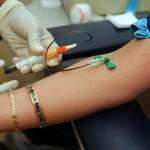
“This is the first connection in humans between a neurotransmitter in the brain and an autistic behavioral symptom,” explains MIT McGovern Institute for Brain Research postdoc student Caroline Robertson PhD.
The lead author of a new study connected to this research goes on to explains that the role of GABA is as a signal inhibitor, preventing brain cells from operating as response to external stimuli.
She explains, “GAMA is responsible for signaling that neurons should turn off, or stop firing. It tends to come into play when information is being transmitted and it needs to be shut down or filtered out.”
The study binocular rivalry—which is a type of visual function—in 20 adults who had been diagnosed with autism. They also studied 21 control adults. For the binocular rivalry rest, the scientists showed each group two images—one image presented to each eye, simultaneously—to observe how the competed for perception dominance in the brain.
The researchers speculate that hypersensitivity to the external environment can make it difficult for a person with autism to ignore or tune out distracting sensations, sounds, etc, which can result in feeling overwhelmed in highly stimulating situations. Some children with autism, for example, can be easily distracted by itchy clothing or even by softer ambient noise. The researchers also suggest that hypersensitivity can play a major role in the condition’s mains symptoms which includes things like repetitive behaviors, social skill impairment, and difficulty with communicating.
Basically, the study concludes that when GABA does not do the job it is designed to do—either by malfunction or by simply the lack of it—it is more difficult for the brain to focus amidst environmental distractions.
Robertson concludes, then, “Individuals with autism are known to have detail-oriented visual perception — exhibiting remarkable attention to small details in the sensory environment and difficulty filtering out or suppressing irrelevant sensory information. It’s long been thought this might have something to do with inhibition in the brain, and our findings lend support to this notion.”
This study has been published in the journal Current Biology.








